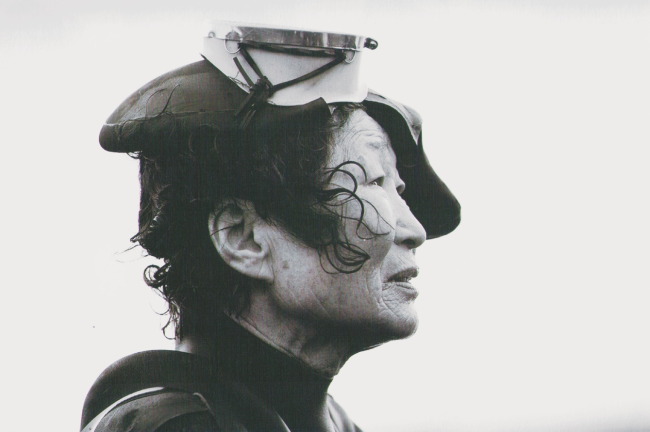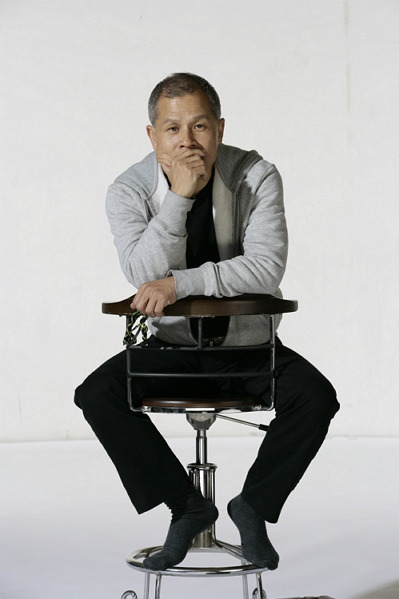[Weekender] Haenyeo up close and personal
Photographer Joon Choi returns with precious cache after year among women divers on Udo Island
By Korea HeraldPublished : June 20, 2014 - 19:40
Larger-than-life photographs of Jejudo Island’s iconic female divers in wetsuits hang on the walls of the second and basement floor spaces of POSCO Art Museum on Tehran-ro in southern Seoul, the women’s weathered faces bearing witness to a lifetime of struggles with the sea. The photographs are part of “Mother in the Sea, Haenyeo,” an exhibition of 165 works by celebrated photographer Joon Choi, running through July 3.
Choi captures the faraway look in the eyes of an aged diver just out of the water, her exertion apparent in the deep furrows of her face. He catches yet another haenyeo, or jamsu as the women divers are also called, in a moment of dance, her lean body slightly angled, her hands holding up her flippers in a seemingly joyful, rhythmic movement.
The occasional landscapes of Jejudo Island interspersed among the portraits capture the wind blowing through a field of grass, the quiet calm of a steely gray sea before a storm ― raw elements of nature that these special women endure every day.
Choi captures the faraway look in the eyes of an aged diver just out of the water, her exertion apparent in the deep furrows of her face. He catches yet another haenyeo, or jamsu as the women divers are also called, in a moment of dance, her lean body slightly angled, her hands holding up her flippers in a seemingly joyful, rhythmic movement.
The occasional landscapes of Jejudo Island interspersed among the portraits capture the wind blowing through a field of grass, the quiet calm of a steely gray sea before a storm ― raw elements of nature that these special women endure every day.

The intimate portraits are a surprise given the exclusive nature of the haenyeo community. “I was able to get those pictures because I lived with them for a year,” said Choi at his studio in Gaepo-dong, Seoul, on May 26.
Living among the subjects is not the sole explanation, however. A week earlier, on Jejudo Island, I had had a glimpse of Choi’s uncanny ability to get complete strangers to pose for him ― cajoling and coaxing them, pulling them this way, pushing them that way. It was marvelous to witness how the famously taciturn haenyeo could be moved to break into a big, bright smile by this man.
Perhaps it was the charisma exuding from his small but tight frame that made the women drop their guard? Perhaps it was the pleading yet commanding tone in his voice that got the reluctant women to do his bidding?
At his studio, Choi has a simple answer: Love. “Whoever I may be facing, my bottom-line philosophy is love for my fellow men,” he said, quickly adding, “Maybe this allows me to get away with being a dictator!” with a laugh.
Upon returning to Seoul in 1988 following years of studying in Japan and working in New York, Choi took the commercial photography scene here by storm. Armed with the latest know-how and trends from New York, the city at the vanguard of the advertising industry, Choi quickly became the most sought-after photographer, fetching record sums for his innovative works.
The name Joon Choi quickly became associated with a Western mood, special effects and a “sizzle,” according to Choi. He was particularly favored for corporate PR campaigns and by financial firms and hotels.

After some 15 years as the country’s most successful commercial photographer, however, Choi became disillusioned. “When celebrities came in to do shoots for commercials, I couldn’t breathe. It was showing off on both sides. It felt empty,” he said. “I asked myself if I could do something that felt meaningful to me. I asked myself, ‘What is my standard of aesthetics?’” he recalled. “But there was also the question of the need for a livelihood.”
An opportunity arose in 2006 that shook Choi out of the rut, a project that, in retrospect, was a turning point in his career. The chief of Buyeo National Museum, who had been persuading Choi to work with him for three or four years, called about doing a catalogue of Baekje artifacts. “He wanted a catalogue but I wanted something on a larger scale. I always liked large,” Choi said.
The result of a more-than-yearlong labor of love was an unprecedented catalogue of 41 Baekje relics captured in 101 photographs. And large it was ― the book was slightly larger than a broadsheet newspaper. “Baekje” was sold for a record-breaking price of 2 million won ($1,960).
The catalogue was sensational for its fresh approach to viewing artifacts. Instead of full-length shots, Choi trained his lens on specific parts of a relic, as in the close-up shot of the face of “Gilt-Bronze Maitreya in Meditation” that captures its serene, benevolent and graceful facial expression. Choi gave each object a befitting background ― “Gilt-Bronze Incense Burner of Baekje” is set against mountains shrouded in misty clouds, the mist conjuring up the image of incense smoke rising.
“‘Gilt-bronze Maitreya in Meditation’ was a turning point in my career. I looked toward inner beauty and the results confirmed that my concept of beauty was not wrong,” Choi said.
In recent years, Choi has been focusing on portraits, producing candid portraits of familiar public figures ranging from powerful politicians to iconic artists. Choi’s portraits now are remarkable for their honesty, which he attributes to his age. In his younger days, Choi’s wife used to chide him for unnatural, stiff portraits, he recalled.
“This sort of loosening up comes with age. Experience is absolutely necessary to do portraits. You and your subject must be at least equal in terms of life experience, otherwise the photographer is overwhelmed by his subject,” Choi said. “I am at the best age to do portraits now, because it requires a breadth of life (experience),” he added.
More than anything else, however, love and consideration for the subject is essential in portrait photography, according to Choi. “Photographers are required to capture the moment, to not miss a golden opportunity. There are times when we need to dismiss our humanity and, personally, I dislike this aspect of photography,” said Choi.
In photographing the female divers, Choi exercised great sensitivity. “After several hours in the water, they return with loads weighing as much as 40-50 kg and I see faces that have been to hell and back. These are expressions that I should not miss. But I just could not bring myself to shoot just then. I took the photographs with great circumspection,” Choi said. “In a way, it was a test of my character. The present score is not bad,” he said.
What did Choi get out of the haenyeo project, a project he took on to champion the cause of a UNESCO-listing for the women divers?
“It was the first year that I lived for my own satisfaction. I was able to confirm the quality of my standard of aesthetics and it was recognized by others. I also overcame my timorousness about art,” he said.
Choi had also wanted to show his son how to reach a turning point in life. “My generation lives through two generations. My son may live through three generations. I wanted to teach him by example,” he said.
By Kim Hoo-ran, Senior writer (khooran@heraldcorp.com)
-
Articles by Korea Herald









![[Kim Seong-kon] Democracy and the future of South Korea](http://res.heraldm.com/phpwas/restmb_idxmake.php?idx=644&simg=/content/image/2024/04/16/20240416050802_0.jpg&u=)








![[KH Explains] Hyundai's full hybrid edge to pay off amid slow transition to pure EVs](http://res.heraldm.com/phpwas/restmb_idxmake.php?idx=652&simg=/content/image/2024/04/18/20240418050645_0.jpg&u=20240418181020)

![[Today’s K-pop] Zico drops snippet of collaboration with Jennie](http://res.heraldm.com/phpwas/restmb_idxmake.php?idx=642&simg=/content/image/2024/04/18/20240418050702_0.jpg&u=)